radiator cap DODGE CHALLENGER 2011 3.G Owners Manual
[x] Cancel search | Manufacturer: DODGE, Model Year: 2011, Model line: CHALLENGER, Model: DODGE CHALLENGER 2011 3.GPages: 490, PDF Size: 6.22 MB
Page 352 of 490
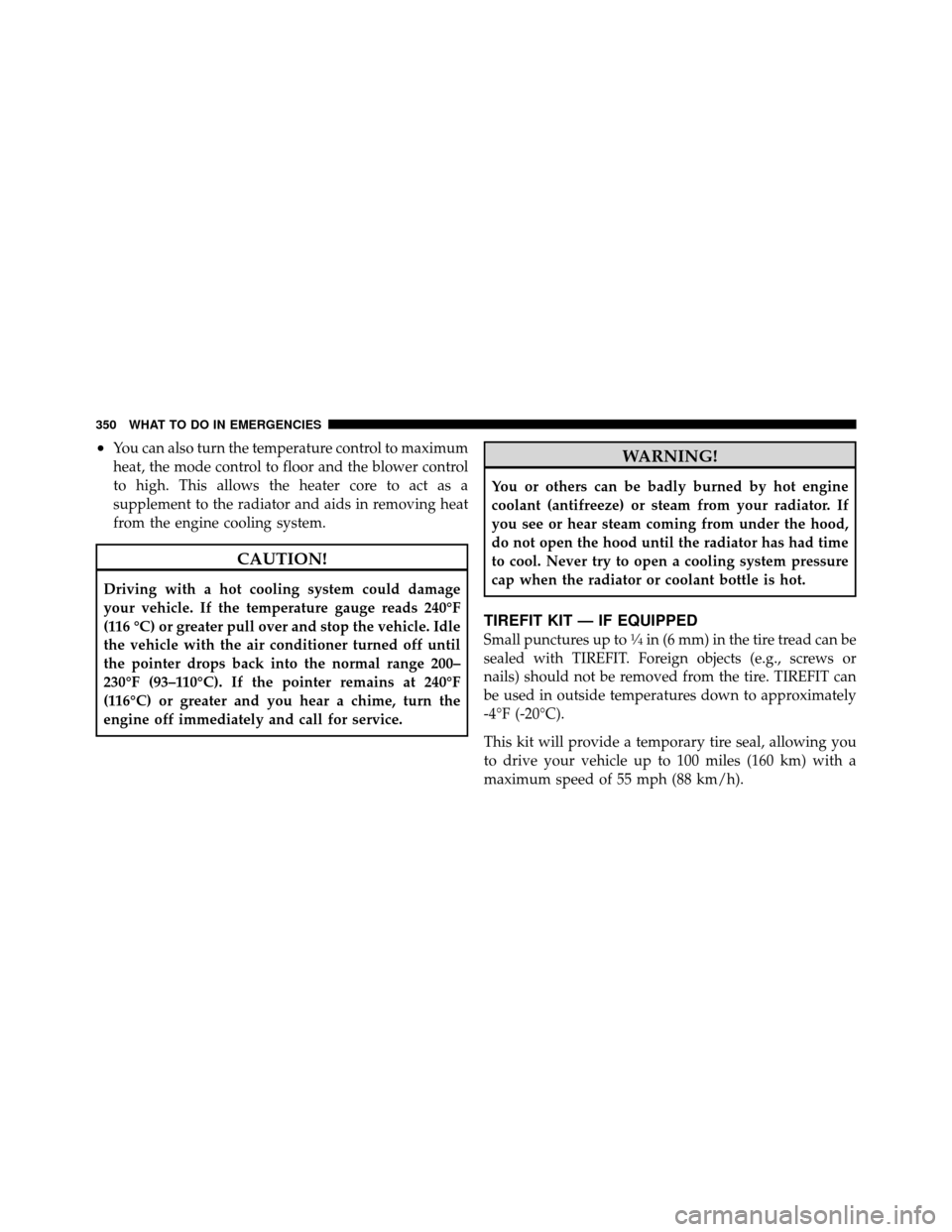
•You can also turn the temperature control to maximum
heat, the mode control to floor and the blower control
to high. This allows the heater core to act as a
supplement to the radiator and aids in removing heat
from the engine cooling system.
CAUTION!
Driving with a hot cooling system could damage
your vehicle. If the temperature gauge reads 240°F
(116 °C) or greater pull over and stop the vehicle. Idle
the vehicle with the air conditioner turned off until
the pointer drops back into the normal range 200–
230°F (93–110°C). If the pointer remains at 240°F
(116°C) or greater and you hear a chime, turn the
engine off immediately and call for service.
WARNING!
You or others can be badly burned by hot engine
coolant (antifreeze) or steam from your radiator. If
you see or hear steam coming from under the hood,
do not open the hood until the radiator has had time
to cool. Never try to open a cooling system pressure
cap when the radiator or coolant bottle is hot.
TIREFIT KIT — IF EQUIPPED
Small punctures up to1�4in (6 mm) in the tire tread can be
sealed with TIREFIT. Foreign objects (e.g., screws or
nails) should not be removed from the tire. TIREFIT can
be used in outside temperatures down to approximately
-4°F (-20°C).
This kit will provide a temporary tire seal, allowing you
to drive your vehicle up to 100 miles (160 km) with a
maximum speed of 55 mph (88 km/h).
350 WHAT TO DO IN EMERGENCIES
Page 404 of 490
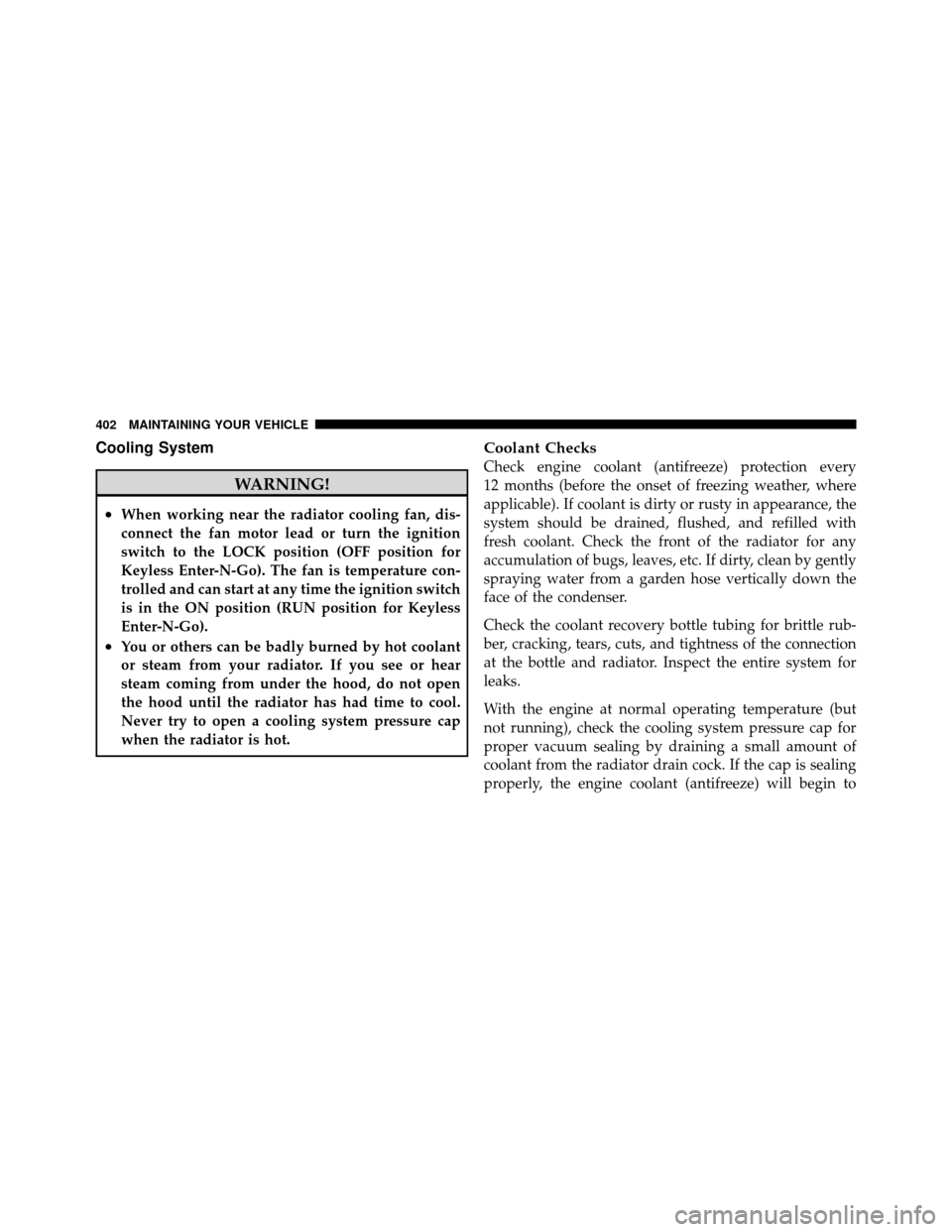
Cooling System
WARNING!
•When working near the radiator cooling fan, dis-
connect the fan motor lead or turn the ignition
switch to the LOCK position (OFF position for
Keyless Enter-N-Go). The fan is temperature con-
trolled and can start at any time the ignition switch
is in the ON position (RUN position for Keyless
Enter-N-Go).
•You or others can be badly burned by hot coolant
or steam from your radiator. If you see or hear
steam coming from under the hood, do not open
the hood until the radiator has had time to cool.
Never try to open a cooling system pressure cap
when the radiator is hot.
Coolant Checks
Check engine coolant (antifreeze) protection every
12 months (before the onset of freezing weather, where
applicable). If coolant is dirty or rusty in appearance, the
system should be drained, flushed, and refilled with
fresh coolant. Check the front of the radiator for any
accumulation of bugs, leaves, etc. If dirty, clean by gently
spraying water from a garden hose vertically down the
face of the condenser.
Check the coolant recovery bottle tubing for brittle rub-
ber, cracking, tears, cuts, and tightness of the connection
at the bottle and radiator. Inspect the entire system for
leaks.
With the engine at normal operating temperature (but
not running), check the cooling system pressure cap for
proper vacuum sealing by draining a small amount of
coolant from the radiator drain cock. If the cap is sealing
properly, the engine coolant (antifreeze) will begin to
402 MAINTAINING YOUR VEHICLE
Page 405 of 490
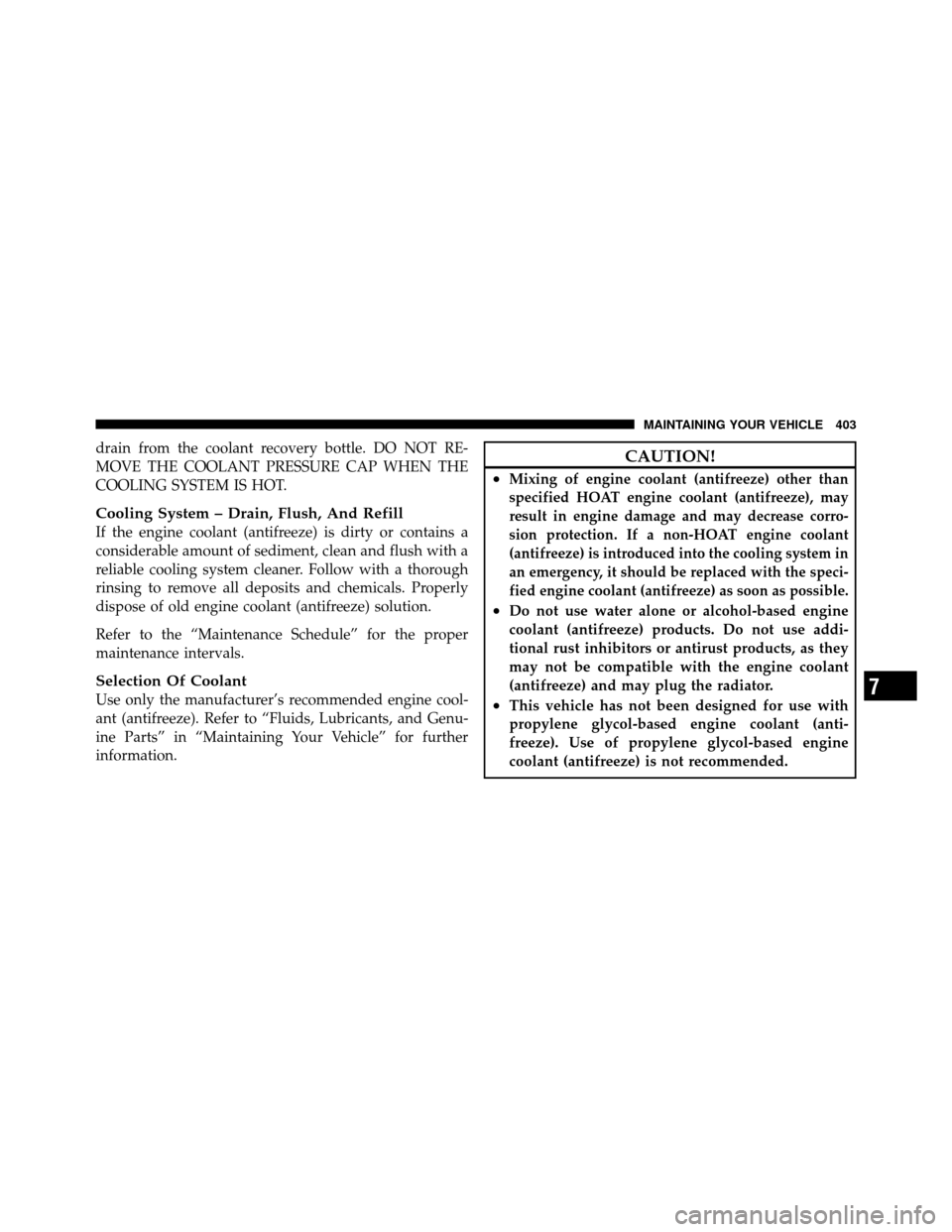
drain from the coolant recovery bottle. DO NOT RE-
MOVE THE COOLANT PRESSURE CAP WHEN THE
COOLING SYSTEM IS HOT.
Cooling System – Drain, Flush, And Refill
If the engine coolant (antifreeze) is dirty or contains a
considerable amount of sediment, clean and flush with a
reliable cooling system cleaner. Follow with a thorough
rinsing to remove all deposits and chemicals. Properly
dispose of old engine coolant (antifreeze) solution.
Refer to the “Maintenance Schedule” for the proper
maintenance intervals.
Selection Of Coolant
Use only the manufacturer’s recommended engine cool-
ant (antifreeze). Refer to “Fluids, Lubricants, and Genu-
ine Parts” in “Maintaining Your Vehicle” for further
information.
CAUTION!
•Mixing of engine coolant (antifreeze) other than
specified HOAT engine coolant (antifreeze), may
result in engine damage and may decrease corro-
sion protection. If a non-HOAT engine coolant
(antifreeze) is introduced into the cooling system in
an emergency, it should be replaced with the speci-
fied engine coolant (antifreeze) as soon as possible.
•Do not use water alone or alcohol-based engine
coolant (antifreeze) products. Do not use addi-
tional rust inhibitors or antirust products, as they
may not be compatible with the engine coolant
(antifreeze) and may plug the radiator.
•This vehicle has not been designed for use with
propylene glycol-based engine coolant (anti-
freeze). Use of propylene glycol-based engine
coolant (antifreeze) is not recommended.
7
MAINTAINING YOUR VEHICLE 403
Page 407 of 490

Cooling System Pressure Cap
The cap must be fully tightened to prevent loss of engine
coolant (antifreeze), and to ensure that engine coolant
(antifreeze) will return to the radiator from the coolant
recovery bottle.
The cap should be inspected and cleaned if there is any
accumulation of foreign material on the sealing surfaces.
WARNING!
•The warning words “DO NOT OPEN HOT” on the
cooling system pressure cap are a safety precaution.
Never add engine coolant (antifreeze) when the
engine is overheated. Do not loosen or remove the
cap to cool an overheated engine. Heat causes
pressure to build up in the cooling system. To
prevent scalding or injury, do not remove the pres-
sure cap while the system is hot or under pressure.
(Continued)
WARNING! (Continued)
•Do not use a pressure cap other than the one
specified for your vehicle. Personal injury or en-
gine damage may result.
Disposal Of Used Coolant
Used ethylene glycol-based engine coolant (antifreeze) is
a regulated substance requiring proper disposal. Check
with your local authorities to determine the disposal
rules for your community. To prevent ingestion by ani-
mals or children, do not store ethylene glycol-based
engine coolant (antifreeze) in open containers or allow it
to remain in puddles on the ground. If ingested by a child
or pet, seek emergency assistance immediately. Clean up
any ground spills immediately.
Coolant Level
The coolant bottle provides a quick visual method for
determining that the engine coolant (antifreeze) level is
7
MAINTAINING YOUR VEHICLE 405
Page 408 of 490
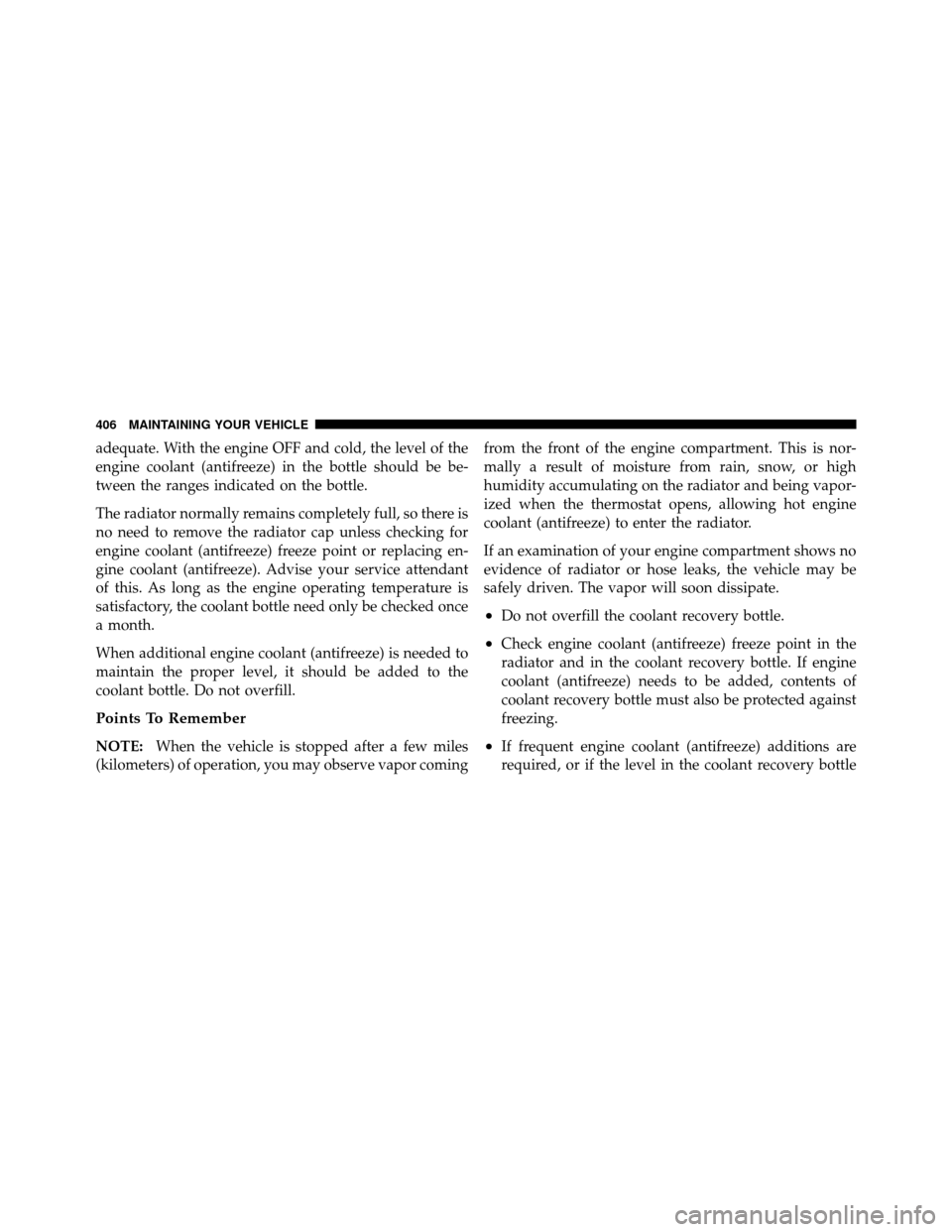
adequate. With the engine OFF and cold, the level of the
engine coolant (antifreeze) in the bottle should be be-
tween the ranges indicated on the bottle.
The radiator normally remains completely full, so there is
no need to remove the radiator cap unless checking for
engine coolant (antifreeze) freeze point or replacing en-
gine coolant (antifreeze). Advise your service attendant
of this. As long as the engine operating temperature is
satisfactory, the coolant bottle need only be checked once
a month.
When additional engine coolant (antifreeze) is needed to
maintain the proper level, it should be added to the
coolant bottle. Do not overfill.
Points To Remember
NOTE:When the vehicle is stopped after a few miles
(kilometers) of operation, you may observe vapor coming from the front of the engine compartment. This is nor-
mally a result of moisture from rain, snow, or high
humidity accumulating on the radiator and being vapor-
ized when the thermostat opens, allowing hot engine
coolant (antifreeze) to enter the radiator.
If an examination of your engine compartment shows no
evidence of radiator or hose leaks, the vehicle may be
safely driven. The vapor will soon dissipate.
•Do not overfill the coolant recovery bottle.
•Check engine coolant (antifreeze) freeze point in the
radiator and in the coolant recovery bottle. If engine
coolant (antifreeze) needs to be added, contents of
coolant recovery bottle must also be protected against
freezing.
•If frequent engine coolant (antifreeze) additions are
required, or if the level in the coolant recovery bottle
406 MAINTAINING YOUR VEHICLE
Page 409 of 490

does not drop when the engine cools, the cooling
system should be pressure tested for leaks.
•Maintain engine coolant (antifreeze) concentration at
50% HOAT engine coolant (antifreeze) (minimum)
and distilled water for proper corrosion protection of
your engine, which contains aluminum components.
•Make sure that the radiator and coolant recovery
bottle overflow hoses are not kinked or obstructed.
•Keep the front of the radiator clean. If your vehicle is
equipped with air conditioning, keep the front of the
condenser clean.
•Do not change the thermostat for Summer or Winter
operation. If replacement is ever necessary, install
ONLY the correct type thermostat. Other designs may
result in unsatisfactory engine coolant (antifreeze)
performance, poor gas mileage, and increased
emissions.
Brake System
In order to assure brake system performance, all brake
system components should be inspected periodically.
Refer to the “Maintenance Schedule” for the proper
maintenance intervals.
WARNING!
Riding the brakes can lead to brake failure and
possibly a collision. Driving with your foot resting or
riding on the brake pedal can result in abnormally
high brake temperatures, excessive lining wear, and
possible brake damage. You would not have your full
braking capacity in an emergency.
7
MAINTAINING YOUR VEHICLE 407
Page 470 of 490
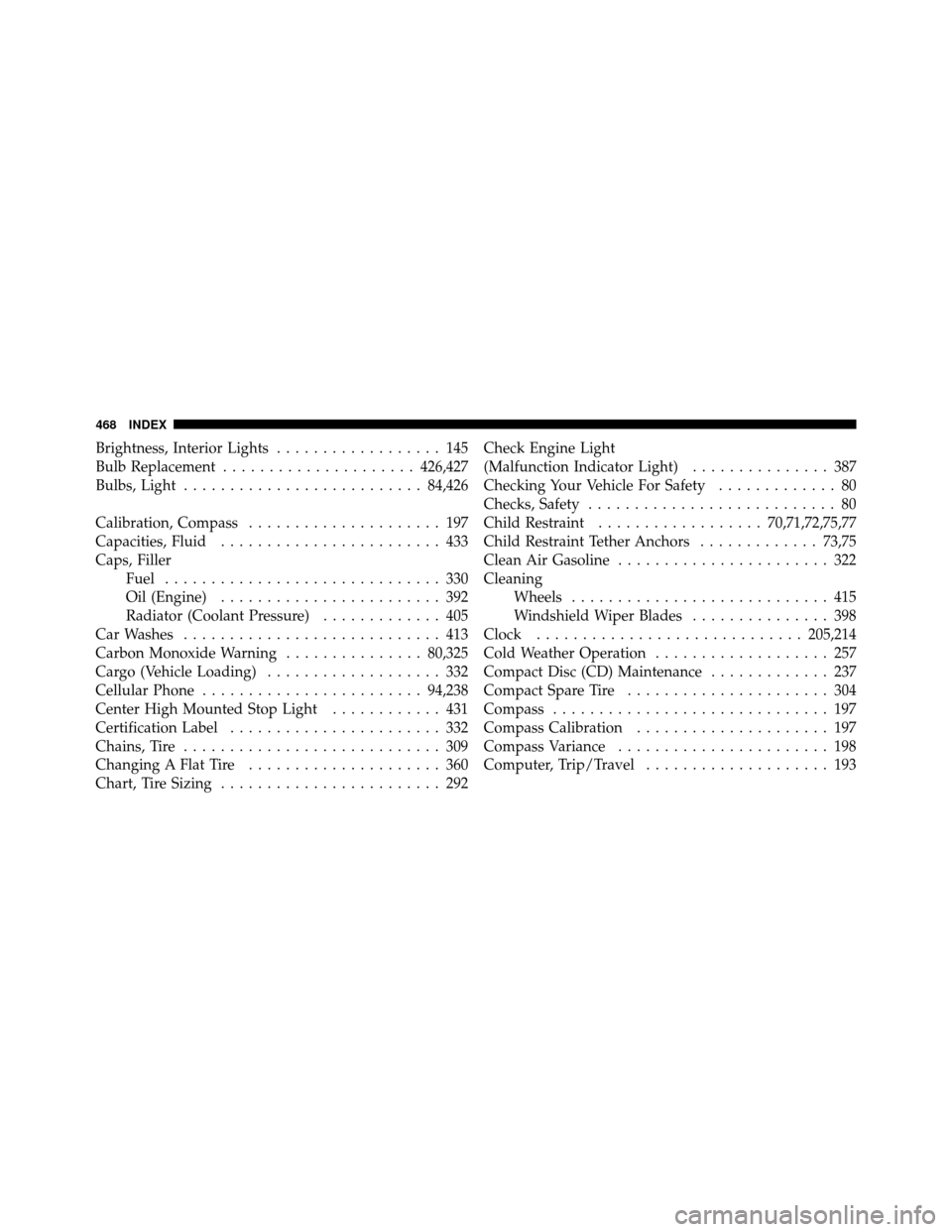
Brightness, Interior Lights.................. 145
Bulb Replacement ..................... 426,427
Bulbs, Light .......................... 84,426
Calibration, Compass ..................... 197
Capacities, Fluid ........................ 433
Caps, Filler Fuel .............................. 330
Oil (Engine) ........................ 392
Radiator (Coolant Pressure) ............. 405
Car Washes ............................ 413
Carbon Monoxide Warning ...............80,325
Cargo (Vehicle Loading) ................... 332
Cellular Phone ........................ 94,238
Center High Mounted Stop Light ............ 431
Certification Label ....................... 332
Chains, Tire ............................ 309
Changing A Flat Tire ..................... 360
Chart, Tire Sizing ........................ 292 Check Engine Light
(Malfunction Indicator Light)
............... 387
Checking Your Vehicle For Safety ............. 80
Checks, Safety ........................... 80
Child Restraint .................. 70,71,72,75,77
Child Restraint Tether Anchors .............73,75
Clean Air Gasoline ....................... 322
Cleaning Wheels ............................ 415
Windshield Wiper Blades ............... 398
Clock ............................. 205,214
Cold Weather Operation ................... 257
Compact Disc (CD) Maintenance ............. 237
Compact Spare Tire ...................... 304
Compass .............................. 197
Compass Calibration ..................... 197
Compass Variance ....................... 198
Computer, Trip/Travel .................... 193
468 INDEX
Page 471 of 490
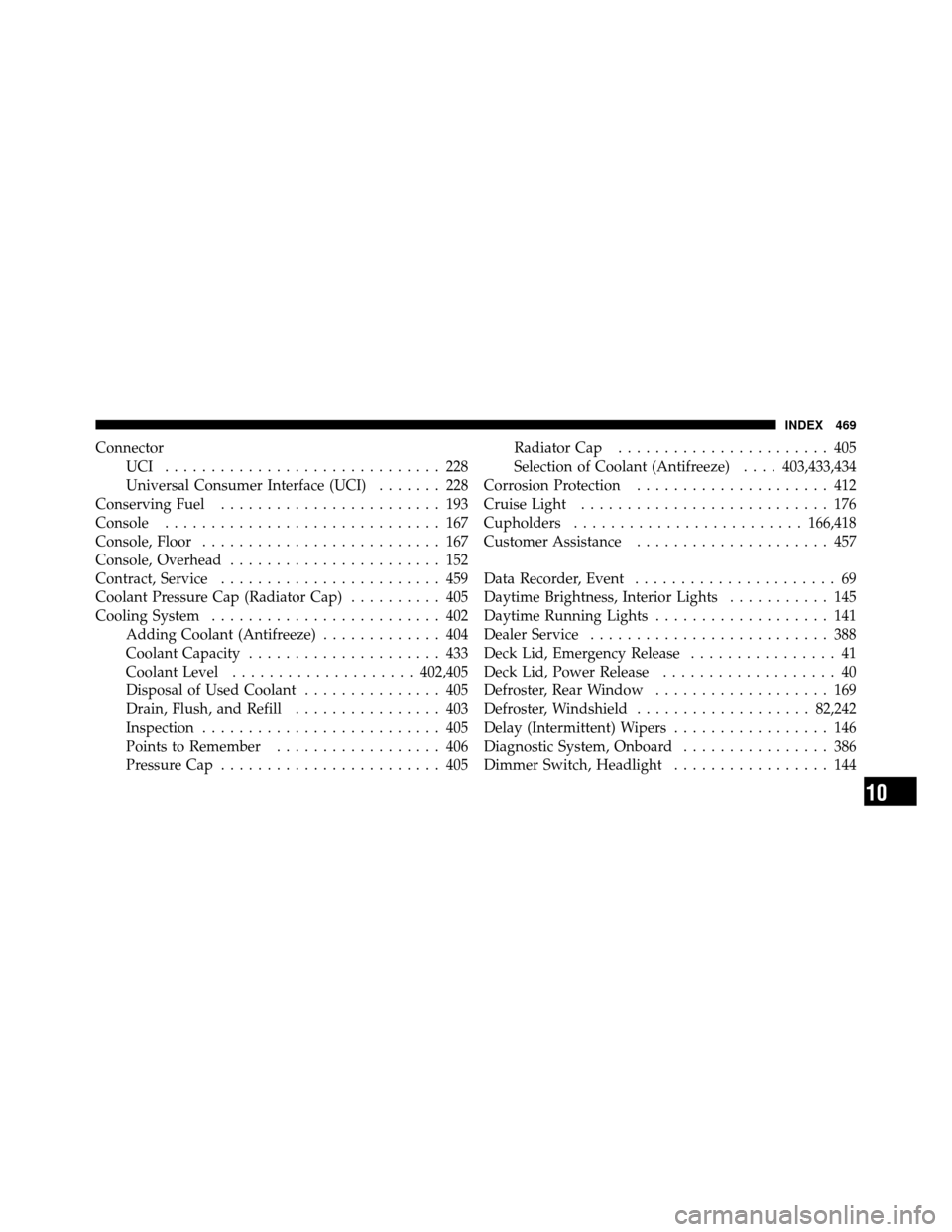
ConnectorUCI .............................. 228
Universal Consumer Interface (UCI) ....... 228
Conserving Fuel ........................ 193
Console .............................. 167
Console, Floor .......................... 167
Console, Overhead ....................... 152
Contract, Service ........................ 459
Coolant Pressure Cap (Radiator Cap) .......... 405
Cooling System ......................... 402
Adding Coolant (Antifreeze) ............. 404
Coolant Capacity ..................... 433
Coolant Level .................... 402,405
Disposal of Used Coolant ............... 405
Drain, Flush, and Refill ................ 403
Inspection .......................... 405
Points to Remember .................. 406
Pressure Cap ........................ 405 Radiator Cap
....................... 405
Selection of Coolant (Antifreeze) ....403,433,434
Corrosion Protection ..................... 412
Cruise Light ........................... 176
Cupholders ......................... 166,418
Customer Assistance ..................... 457
Data Recorder, Event ...................... 69
Daytime Brightness, Interior Lights ........... 145
Daytime Running Lights ................... 141
Dealer Service .......................... 388
Deck Lid, Emergency Release ................ 41
Deck Lid, Power Release ................... 40
Defroster, Rear Window ................... 169
Defroster, Windshield ................... 82,242
Delay (Intermittent) Wipers ................. 146
Diagnostic System, Onboard ................ 386
Dimmer Switch, Headlight ................. 144
10
INDEX 469
Page 481 of 490

Overheating, Engine................... 178,349
Owner’s Manual (Operator Manual) .........4,461
Paint Care ............................. 412
Panic Alarm ............................ 25
Parking Brake .......................... 278
Passing Light ........................... 144
Personal Settings ........................ 199
Pets .................................. 79
Phone, Cellular .......................... 94
Phone, Hands-Free (Uconnect™) .............. 94
Placard, Tire and Loading Information ......... 296
Power Brakes ............................ 281
Deck Lid Release ..................... 40
Distribution Center (Fuses) .............. 421
Door Locks ......................... 31
Mirrors ............................ 91
Outlet (Auxiliary Electrical Outlet) ........ 162Seats
............................. 128
Steering ........................... 277
Sunroof ........................... 159
Windows ........................... 38
Power Steering Fluid ..................... 435
Pregnant Women and Seat Belts .............. 55
Preparation for Jacking .................... 363
Pretensioners Seat Belts ........................... 53
Programmable Electronic Features ............ 199
Programming Transmitters
(Remote Keyless Entry) .................... 21
Radial Ply Tires ......................... 303
Radiator Cap (Coolant Pressure Cap) .......... 405
Radio Operation ........................ 238
Radio Remote Controls .................... 236
Rear Cupholder ......................... 167
Rear Seat, Folding ....................... 136
10
INDEX 479